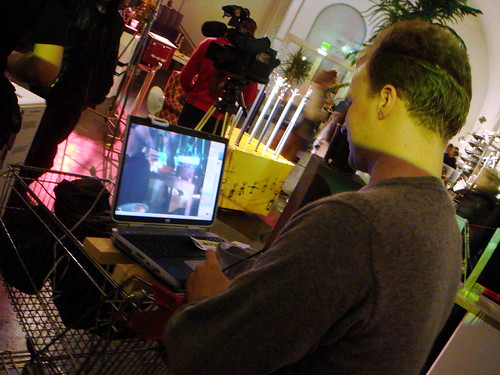Motivations for tagging: organization and communication motives on Facebook
Increasing valuable annotation behaviors was a practical end of a good deal of work at Yahoo! Research Berkeley. ZoneTag is a mobile application and service that suggests tags when users choose to upload a photo (to Flickr) based on their past tags, the relevant tags of others, and events and places nearby. Through social influence and removing barriers, these suggestions influence users to expand and consistently use their tagging vocabulary (Ahern et al. 2006).
Context-aware suggestion techniques such as those used in ZoneTag can increase tagging, but what about users’ motivations for considering tagging in the first place? And how can these motivations for annotation be considered in designing services that involve annotation? In this post, I consider existing work on motivations for tagging, and I use tagging on Facebook as an example of how multiple motivations can combine to increase desired annotation behaviors.
Using photo-elicitation interviews with ZoneTag users who tag, Ames & Naaman (2007) present a two factor taxonomy of motivations for tagging. First, they categorize tagging motivations by function: is the motivating function of the tagging organizational or communicative? Organizational functions include supporting search, presenting photos by event, etc., while communicative functions include when tags provide information about the photos, their content, or are otherwise part of a communication (e.g., telling a joke). Second, they categorize tagging motivations by intended audience (or sociality): are the tags intended for my future self, people known to me (friends, family, coworkers, online contacts), or the general public?

On Flickr the function dimension generally maps onto the distinction between functionality that enables and is prior to arriving at the given photo or photos (organization) and functionality applicable once one is viewing a photo (communication). For example, I can find a photo (by me or someone else) by searching for a person’s name, and then use other tags applied to that photo to jog my memory of what event the photo was taken at.
Some Flickr users subscribe to RSS feeds for public photos tagged with their name, making for a communication function of tagging — particularly tagging of people in media — that is prior to “arriving” at a specific media object. These are generally techie power users, but this can matter for others. Some less techie participants in our studies reported noticing that their friends did this — so they became aware of tagging those friends’ names as a communicative act that would result in the friends finding the tagged photos.
This kind of function of tagging people is executed more generally — and for more than just techie power users — by Facebook. In tagging of photos, videos, and blog posts, tagging a person notifies them they have been tagged, and can add that they have been tagged to their friends’ News Feeds. This function has received a lot of attention from a privacy perspective (and it should). But I think it hints at the promise of making annotation behavior fulfill more of these functions simultaneously. When specifying content can also be used to specify recipients, annotation becomes an important trigger for communication.
—————
See some interesting comments (from Twitter) about tagging on Facebook:
- noticing people tagging to gain eyeballs
- exhorting others not to tag bad photos (and thanks)
- collapsing time by tagging photos from long ago
- tagging by parents
(Also see Facebook’s growing use and testing of autotagging [1, 2].)
References
Ames, M., & Naaman, M. (2007). Why we tag: motivations for annotation in mobile and online media. In Proceedings of CHI 2007 (pp. 971-980). San Jose, California, USA: ACM.
Ahern, S., Davis, M., Eckles, D., King, S., Naaman, M., Nair, R., et al. (2006). Zonetag: Designing context-aware mobile media capture to increase participation. Pervasive Image Capture and Sharing: New Social Practices and Implications for Technology Workshop. In Adjunct Proc. Ubicomp 2006.
Update your Facebook status: social comparison and the availability heuristic
[Update: This post uses an older Facebook UI as an example. Also see more recent posts on activity streams and the availability heuristic.]
Over at Captology Notebook, the blog of the Stanford Persuasive Technology Lab, Enrique Allen considers features of Facebook that influence users to update their status. Among other things, he highlights how Facebook lowers barriers to updating by giving users a clear sense of something they can right (“What are you doing right now?”).
I’d like to add another part of the interface for consideration: the box in the left box of the home page that shows your current status update with the most recent updates of your friends.

This visual association of my status and the most recent status updates of my friends seems to do at least a couple things:
Influencing the frequency of updates. In this example, my status was updated a few days ago. On the other hand, the status updates from my friends were each updated under an hour ago. This juxtaposes my stale status with the fresh updates of my peers. This can prompt comparison between their frequency of updates and mine, encouraging me to update.
The choice of the most recent updates by my Facebook friends amplifies this effect. Through automatic application of the availability heuristic, this can make me overestimate how recently my friends have updated their status (and thus the frequency of status updates). For example, the Facebook friend who updated their status three minutes ago might have not updated to three weeks prior. Or many of my Facebook friends may not frequently update their status messages, but I only see (and thus have most available to mind) the most recent. This is social influence through enabling and encouraging biased social comparison with — in a sense — an imagined group of peers modeled on those with the most recent performances of the target behavior (i.e., updating status).
Influencing the content of updates. In his original post, Enrique mentions how Facebook ensures that users have the ability to update their status by giving them a question that they can answer. Similarly, this box also gives users examples from their peers to draw on.
Of course, this can all run up against trouble. If I have few Facebook friends, none of them update their status much, or those who do update their status are not well liked by me, this comparison may fail to achieve increased updates.
Consider this interface in comparison to one that either
- showed recent status updates by your closest Facebook friends, or
- showed recent status updates and the associated average period for updates of your Facebook friends that most frequently update their status.
[Update: While the screenshot above is from the “new version” of Facebook, since I captured it they have apparently removed other people’s updates from this box on the home page, as Sasha pointed out in the comments. I’m not sure why they would do this, but here are couple ideas:
- make lower items in this sidebar (right column) more visable on the home page — including the ad there
- emphasize the filter buttons at the top of the news feed (left column) as the means to seeing status updates.
Given the analysis in the original post, we can consider whether this change is worth it: does this decrease status updates? I wonder if Facebook did a A-B test of this: my money would be on this significantly reducing status updates from the home page, especially from users with friends who do update their status.]
Laptop + shopping cart = mobile
This guy can roll up with laptop and webcam to record robots (photo CC from violetblue):
But in Silicon Valley, combining laptops and shopping carts is just a way to get chores done. When at Whole Foods in Los Altos, I saw a man pushing a shopping cart with a laptop in the part where you can sit your toddler. I suppose he was reading a recipe or something. (I, and I’m sure other Valley folks, do that on a phone.)
A bit odd, but then again, I used to be (I’ve fallen off a bit) judicious about capturing the contents of my shopping cart with ZoneTag.
Advanced Soldier Sensor Information System and Technology
Yes, that spells ASSIST.
Check out this call for proposals from DARPA (also see Wired News). This research program is designed to create and evaluate systems that use sensors to capture soldiers’ experiences in the field, thus allowing for (spatially and temporally) distant review and analysis of this data, as well as augmenting their abilities while still in the field.
I found it interesting to consider differences in requirements between this program and others that would apply some similar technologies and involve similar interactions — but for other purposes. For example, two such uses are (1) everyday life recording for social sharing and memory and (2) rich data collection as part of ethnographic observation and participation.
When doing some observation myself, I strung my cameraphone around my neck and used Waymarkr to automatically capture a photo every minute or so. Check out the results from my visit to a flea market in San Francisco.


Photos of two ways to wear a cameraphone from Waymarkr. Incidentally, Waymarkr uses the cell-tower-based location API created for ZoneTag, a project I worked on at Yahoo! Research Berkeley.
Also, for a use more like (1) in a fashion context, see Blogging in Motion. This project (for Yahoo! Hack Day) created a “auto-blogging purse” that captures photos (again using ZoneTag) whenever the wearer moves around (sensed using GPS).

